Team
SNuBIC Team
This research unit brings together a selected core team of researchers from Aachen, Augsburg,
Bochum, Cologne, and Düsseldorf, and one associated PI from Munich. This selection combines
expertise in numerical methods and mathematical modeling as well as junior and established levels.
All PIs have extensive experience
in interdisciplinary collaborations between applied mathematicians and computational physicists or
engineers.
Spokesperson of the research unit: Manuel Torrilhon (RWTH Aachen)
Co-Spokesperson of the research unit: Christiane Helzel (Heinrich-Heine-University Düsseldorf)
Members
| Name | .... | Role | .... | Location |
|---|---|---|---|---|
| Daniel Bach | PhD Student | Cologne | ||
| Stefanie Braun | PI | Aachen | ||
| Simon Candelaresi | Post-Doc | Augsburg | ||
| Daniel Döhring | PhD Student | Aachen | ||
| Jürgen Dreher | PI | Bochum | ||
| Bella Duong | PhD Student | Düsseldorf | ||
| Gregor Gassner | PI | Cologne | ||
| Rainer Grauer | PI | Bochum | ||
| Gudrun Grünwald | PhD Student | Bochum | ||
| Christiane Helzel | PI | Düsseldorf | ||
| Yanick Kiechle | PhD Student | Düsseldorf | ||
| Katharina Kormann | PI | Bochum | ||
| Omar Malik | PhD Student | Bochum | ||
| Aleksandr Mustonen | Post-Doc | Bochum | ||
| Michael Schlottke-Lakemper | PI | Augsburg | ||
| Aleksej Sikstel | Post-Doc | Cologne | ||
| Satyvir Singh | Post-Doc | Aachen | ||
| Eric Sonnendrücker | assoc PI | Munich | ||
| Manuel Torrilhon | PI | Aachen | ||
| Eda Yilmaz | PhD Student | Aachen |
Location and PI Overview
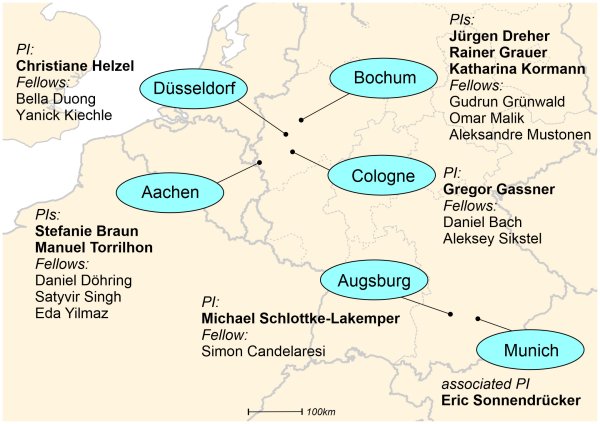
Short Intro of the Members:
SB
Stefanie Braun (PI)
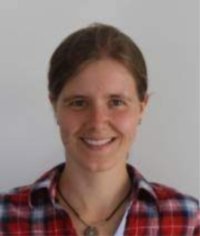
Stefanie Braun’s expertise lies in the mathematical description of fluid and kinetic systems in the presence of electromagnetic fields. She has considerable experience in the field of plasma physics, where she has worked on different aspects of particle transport in hot fusion plasmas Braun, Helander (2010), Braun, Helander et al. (2009), Fülöp, Braun, Pusztai (2010) and on spin effects in quantum plasmas Braun, Asenjo, Mahajan (2012). More recently, Dr. Braun has focused on the modeling of electrochemical systems for battery applications, where she developed a mathematical model for ionic transport in a solid electrolyte Braun, Yada, Latz (2015) that has gained increasing attention in the community. One emphasis lies on the thermodynamic consistency of the model, ensuring the mathematical well-behavedness of the system by rigorously demanding an entropy principle in the derivation of the constitutive laws. In contrast to earlier models, this system can be derived based on first principles only. Dr. Braun is currently a postdoctoral fellow at the Center for Computational Engineering Sciences at RWTH Aachen, where she works, together with the FZ Jülich, on the development of a numerical multi-scale hybrid scheme combining thermodynamics and ab-initio methods to simulate dendritic growth in solid electrolytes. In SNuBIC she is involved in the projects on Electro-Chemistry, Cardiology Models, and Plasma Numerics.
Personal website with contact information: ACoM
JD
Jürgen Dreher (PI)
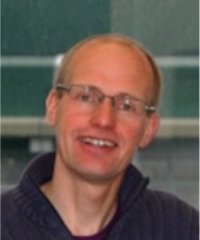
Jürgen Dreher is a senior scientist in the theoretical physics institute at the Ruhr-University Bochum. He has a background in space plasma theory where he investigated the Hall effect in magnetic reconnection using numerical simulations Dreher, Schindler (1997) and devised a dynamical model of magnetosphere-ionosphere coupling Dreher (1997), among other topics. He was the key developer of the distributed-parallel adaptive mesh refinement framework racoon Dreher, Grauer (2005), which has been the basis for numerous scientific projects in plasma physics and fluid dynamics Dreher, Laveder et al. (2005), Grafke, Homann, Dreher, Grauer (2008). Dr. Dreher oversaw the theoretical modeling and related numerical studies of the “FlareLab” plasma experiment, operated in Bochum Tacke, Dreher, Sydora (2013). More recently, he developed interest in the field of cardiac electrophysiology, which is actually closely related to plasma physics as both address the collective dynamics of charged particles under the influence of self-consistent fields, and hence can be described by similar macroscopic model equations. Here, Dr. Dreher gives lectures on Computational Cardiology as part of the Medical Physics curriculum in Bochum, and he has supervised theses on parametric shape optimization in the monodomain model and on Purkinje-Myocardium coupling. In SNuBIC he is involved in the projects on Cardiology Models, Electro-Chemistry, and Parallel Computing.
Personal website with contact information: TP1
GG
Gregor Gassner (PI)
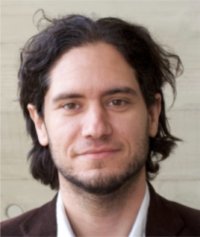
Gregor Gassner and his group work on the development, analysis and efficient implementation of structure-preserving schemes, for nonlinear conservation laws, such as, e.g., the compressible Navier-Stokes or the visco-resistive magnetohydrodynamics equations Bohm, Winters, Gassner et al. (2020), Derigs, Winters, Gassner, Walch (2016), Gassner, Winters et al. (2018), Gassner, Winters, Kopriva (2016). He combines concepts from summation-by-parts finite difference methods with standard nodal DG strategies to develop new schemes, such as split-form DG methods, e.g., in Wintermeyer, Winters, Gassner, Warburton (2018), that allow to preserve auxiliary quantities such as, e.g., entropy or kinetic energy. These novel developments have successfully impacted the high-order DG community, as shown by the invited plenary talk at ICOSAHOM 2018 and the invitation to write a review paper for ‘Frontiers in Physics’ special issue ’Rising Stars’. Dr. Gassner is co-author of several simulation codes, with the newest iteration being Trixi.jl, an open-source 3D AMR split-form DG solver. Since 2018 he is full professor for Applied Mathematics and Scientific Computing at the University of Cologne. In the context of provably stable high-order discretizations for extreme scale parallel computing, he received an ERC starting grant in 2016. In SNuBIC he is involved in the projects on Plasma Numerics, Time Stepping, Plasma Interactions, and Complex Fluids.
Personal website with contact information: NumSim
RG
Rainer Grauer (PI)
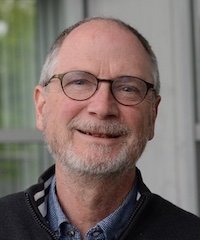
Rainer Grauer and his group focus on two main research directions: the non-perturbative or instanton approach to turbulence, see the review Grafke, Schäfer, Grauer (2015), and the multi-physics treatment of collisionless plasmas Rieke, Trost, Grauer (2015), Lautenbach, Grauer(2018). In the instanton approach, probability density functions of various observables could be calculated by combining theoretical methods from quantum field theory and numerical techniques from optimal control. These studies developed from earlier research on singularity formation in the incompressible Euler equations, especially analyzing the interplay between curvature and divergence of vortex lines Grafke, Grauer (2013). The multi-physics treatment of collisionless plasmas aims at performing large scale simulations of space plasma scenarios including and combining various plasma models. This approach is based on earlier work on Maxwell-Darwin Vlasov simulations Schmitz, Grauer (2006b), Schmitz, Grauer (2006c) including the back-substitution method for the semi-Lagrangian Vlasov scheme. Two fluid (5- and 10-moment) codes coupled to Maxwell's equation including a Landau-damping closure were developed in Allmann-Rahn, Trost, Grauer (2018), Allmann-Rahn, Lautenbach, Grauer (2022), Allmann-Rahn, Grauer, Kormann (2022). Dr. Grauer is heading the chair for Computational Plasma Physics and has been speaker of the DFG research unit 1048 "Instabilities, Turbulence and Transport in Cosmic Magnetic Fields" . In SNuBIC he is involved in the projects on Plasma Interactions, Plasma Numerics, Kinetic Simulations, Moment Models, and Electro-Chemistry.
Personal website with contact information: TP1
CH
Christiane Helzel (PI)
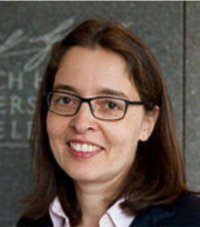
Christiane Helzel’s work is devoted to the development of numerical methods for partial differential equations, with emphasis on hyperbolic and transport dominant problems. She made several contributions to the wave propagation algorithm, for example extending the method to approximate PDEs on the sphere Calhoun, Helzel, LeVeque (2008) and proposing a third order accurate version. Furthermore, she developed Cartesian grid cut cell methods for the approximation of hyperbolic problems in complex geometries Helzel, Berger, Leveque (2005). As member of the DFG-SFB611, she worked on a model for suspensions of rod-like particles Helzel, Otto (2006). This model was later extended Helzel, Tzavaras (2016, Helzel, Tzavaras (2017) to model a sedimentation process. As a member of the DFG research unit 1048, she collaborated with Dr. Dreher and Dr. Grauer and developed a constrained transport method for the three-dimensional MHD equations Helzel, Rossmanith, Taetz (2013) as well as a more accurate WENO method for Cartesian grids with adaptive mesh refinement. Recently, Dr. Helzel contributed to the development of the Active Flux method, a new multidimensional, third order accurate finite volume method Helzel, Kerkmann, Scandurra (2019. Since 2014, Dr. Helzel holds the Chair for Applied Mathematics at the Heinrich-Heine-University of Düsseldorf. In SNuBIC she is involved in the projects on Complex Fluids, Kinetic Simulations, Moment Models, and Parallel Computing.
Personal website with contact information: HHU
KK
Katharina Kormann (PI)
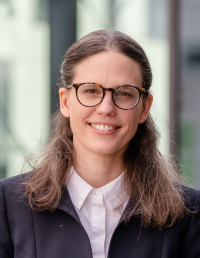
Katharina Kormann's work focuses on numerical algorithms for high-dimensional problems, in particular for kinetic plasma models. She has contributed to the development of structure-preserving methods for the Vlasov--Maxwell system Kraus et al. (2017) and Kormann, Sonnendrücker (2020). She is also interested in the compressed solution of kinetic problems with contributions to sparse grid discretizations Pollinger et al. (2023) as well as low-rank tensor compression Kormann (2015) and Allmann-Rahn, Grauer, Kormann (2022). Another research focus is on high-performance computing with contributions to the distributed solution of grid-based solutions in high dimensions Kormann et al. (2019) and to matrix-free discretization methods Kronbichler, Kormann (2019) in deal.II. Since 2022, she is a professor in numerical analysis at the Ruhr University Bochum. In SNuBIC she is involved in the projects on Low-Rank Approximation, Plasma Numerics, Moment Models, and Parallel Computing.
Personal website with contact information: RUB
MSL
Michael Schlottke-Lakemper (PI)

Michael Schlottke-Lakemper focuses in his research on scalable methods for bulk- and interface-coupled multi-physics simulations, e.g., Schlottke-Lakemper, Winters et al. (2021), with an emphasis on adaptive numerical schemes for complex, large-scale problems that require high-performance computing. In Schlottke-Lakemper, Yu et al. (2017), Schlottke-Lakemper, Niemöller et al. (2019), he presented an efficient strategy for coupling heterogeneous models through a single, shared hierarchical Cartesian mesh. This approach allows to choose the spatial discretization method and grid resolution for each model independently and supports different temporal discretizations. To retain parallel efficiency, he developed a dynamic load balancing scheme to optimize the domain decomposition for coupled simulations on heterogeneous hardware Niemöller, Schlottke-Lakemper et al. (2020). By employing hybrid parallelization techniques, his simulation codes have been demonstrated to scale efficiently to more than 100,000 cores Schlottke-Lakemper, Yu et al. (2017). Furthermore, he is a principal developer of the Julia-based open-source simulation code Trixi.jl Schlottke-Lakemper, Gassner et al. (2021), Ranocha, Schlottke-Lakemper et al. (2022), and has experience with numerical methods for execution on GPU-accelerated systems Kraus, Schlottke et al. (2014). Since 2024, Dr. Schlottke-Lakemper is professor of High-Performance Scientific Computing at the University of Augsburg. In SNuBIC he is involved in the projects on Parallel Computing, Time Stepping, Kinetic Simulations, and Cardiology Models.
Personal website with contact information: Univ Augsburg
ES
Eric Sonnendrücker (PI)

Eric Sonnendrücker is the director of the group for numerical methods for plasma physics at the Max-Planck-Institute for Plasma Physics combined with a professorship at TU Munich. He is an internationally renowned expert in mathematical modeling of plasmas and in the design and analysis of numerical methods. His specialities range from kinetic to continuum models, and both particle Kraus, Kormann, Morrison, Sonnendrücker (2017) and grid-based Crouseilles, Mehrenberger, Sonnendrücker (2010) computational approaches, including electrodynamics Pinto, Sonnendrücker (2016) and structure preservation Kormann, Sonnendrücker (2021), Crouseilles, Ratnani, Sonnendrücker (2012). Dr. Sonnendrücker is principal investigator on several EUROfusion projects and serves as associated editor for SIAM Journal on Scientific Computing and Journal of Computational Physics. He is also member of the advisory board of the Max Planck Computing and Data Facility. In SNuBIC he is involved in the projects on Plasma Interactions, Plasma Numerics, Kinetic Simulations, and Moment Models.
Personal website with contact information: IPP
MT
Manuel Torrilhon (PI)

Manuel Torrilhon and his group work on numerical and mathematical analysis for plasma and gas processes, in particular hyperbolic conservation laws and moment approximation for the Boltzmann equation. His development of regularized moment equations is widely known in the community as was recently highlighted by the invited paper Torrilhon (2016) in the Annual Review of Fluid Mechanics. He also has important contributions to limiter functions of finite volume methods, e.g. Cada, Torrilhon (2009), and the construction of divergence constraint-preserving schemes for magnetohydrodynamics, e.g. Torrilhon (2005). Recently, Dr. Torrilhon developed a hierarchical simulation approach Torrilhon, Sarna (2017) that is able to scale through linear moment models and can be used to estimate model errors from model residuals. The maximum-entropy closure is the most promising technique to extend this framework to the nonlinear regime, but comes with severe computational challenges as demonstrated in Sadr, Torrilhon, Gorji, Schaerer, Bansal, Torrilhon (2017). Dr. Torrilhon’s research has been funded through several individual DFG grants. Currently, he is also member of two DFG Research Training Groups and of the National High Performance Computing Center for Computational Engineering Sciences (NHR4CES) - a joint initiative of RWTH Aachen and the TU Darmstadt. In SNuBIC he is involved in the projects on Moment Models, Time Stepping, Plasma Interactions, Low-Rank Approximations, and Complex Fluids.
Personal website with contact information: ACoM
AM
Alexandr Mustonen (Post-Doc)
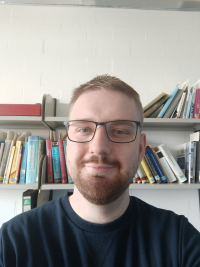
Aleksandr Mustonen is a Post-Doc in the SNuBIC research unit. He received his degree in engineering at the Bauman MSTU, where he worked with various technological plasma setups, specializing in development of Hall ion thrusters using numerical methods. Afterwards, he did his PhD in physics at the Max Planck Institute for Plasma Physics in Garching near Munich, where he developed a semi-Lagrangian hybrid kinetic/driftkinetic code "ssV" for the fusion edge plasma simulations. He is working on the project on Plasma Interactions, investigating the Asymptotic-Preserving framework for the coupling of various plasma models in multi-scale simulations.
DB
Daniel Bach (PhD Student)

Daniel Bach is a PhD student in the SNuBIC research unit. He received his Bachelor and Master degree in Mathematics after studying at the University of Cologne, working specifically with variants of discontinuous Galerkin schemes in a semi discrete form and fully discrete space-time form. Continuing this focus on these kind of schemes, he is working on the project on Plasma Numerics, where a discontinuous Galerkin scheme is coupled with a finite element exterior calculus method to achieve various structure preserving properties in a high-order scheme.
OM
Omar Malik (PhD-Student)
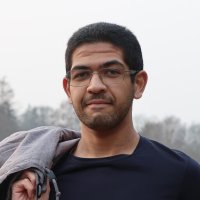
Omar Malik acquired his Bachelor's degree in Chemistry at the University of Sharjah in the United Arab Emirates, where he focused on computational chemistry during his Bachelor's thesis. His interest in computational chemistry has led him to pursue his Master's degree in Computational Science at Uppsala University in Sweden, where he during his Master’s thesis developed an extension of an iterative numerical method for computing density matrices in quantum chemistry that requires fewer iterations to convergence. At the end of his Master’s studies, Omar’s interest has shifted to the development of numerical methods and their applications across multiple domains of science in addition to in chemistry. This has led him to SNuBIC, where he is currently developing dynamical low-rank approximation methods for two-particle kinetic equations.
GGR
Gudrun Grünwald (PhD Student)

Gudrun Grünwald earned her Bachelor's and Master's degrees at the Goethe University of Frankfurt. In her Bachelor's studies, she investigated Surface Plasmon Polaritons (SPPs) in the nanooptics and plasmonics working group. An SPP is a plasma excitation in a metal at an interface to a dielectric coupled to an electromagnetic wave propagating in the latter. Later, she joined the high-energy group at the Max Planck Institute for Extraterrestrial Physics in Garching near Munich, where, as part of her Master's thesis, she researched the behavior of matter under strong gravity in the context of Active Galactic Nuclei (Grünwald 2023, https://doi.org/10.1051/0004-6361/202244620). Gudrun's like of computational physics led her to the B2 project, where she is developing methods for kinetic plasma simulations. Gudrun Grünwald is a PhD student in the SNuBIC research unit.
BD
Bella Duong (PhD Student)

Bella Duong is a PhD student in the SNuBIC research unit. She did her Bachelor's and Master's in computer science. During her master's studies, she focused on numerics. Her master thesis was about Parareal for Stochastic Differential Equation. Now Bella is involved in the project on Complex Fluids.
SS
Satyvir Singh (Post-Doc)

Dr. Satyvir Singh is a postdoctoral research fellow in the research institute of ‘Applied and Computational Mathematics’ at RWTH Aachen University. He earned his Ph.D. in the School of Mechanical and Aerospace Engineering at Gyeongsang National University, South Korea. Subsequently, he worked as a Senior Research Fellow at Research Center for Aircraft Parts Technology, South Korea. After then, he worked as a Research Fellow in School of Physical and Mathematical Sciences at Nanyang Technological University Singapore. His areas of interest in computational sciences include the development of high-order numerical techniques and studying problems related to fluid mechanics, shock wave dynamics, multifluids physics, hydrodynamics instabilities, and continuum-rarefied flows. Within the SNuBIC B4 project, he is working on the development of kinetic moment method for continuum-rarefied gas flows, and adaptive coupling of the maximum-entropy approximation for the Vlasov equation.
EY
Eda Yilmaz (PhD Student)
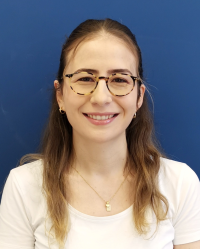
Eda Yılmaz completed her undergraduate and master's degrees in the Mathematics department at different universities. She obtained her bachelor's degree from Dokuz Eylul University in Izmir and her master's degree from Middle East Technical University (METU). During her master's program, she developed a keen interest in partial differential equations and actively engaged in related courses. For her master thesis, she conducted in-depth research on nonlinear Euler systems, expanding her knowledge in this field. Currently, Eda is focusing on nonlinear moment methods in her doctoral studies, aiming to contribute to theoretical and applied research in this area. She seeks to combine mathematical theories with practical applications, with the goal of developing innovative solutions to complex problems. She is involved in the project on Moment Models.
DD
Daniel Döhring (PhD Student)

Daniel Döhring is a PhD Student in the SNuBIC research unit. He is involved in the project on Time Stepping. Daniel received both Bachelor and Master degree in Computational Engineering Science from RWTH Aachen University. During his studies, he studied within an exchange program for one semester at the University of Pennsylvania and later for one semester at ETH Zurich. Currently he is a co-developer of Trixi.jl a high-order discontinuous Galerkin code.
AS
Aleksej Sikstel (Post-Doc)

Aleksej Sikstel is a Post-Doc in the SNuBIC research unit. He is involved in the project on Time Stepping.
SC
Simon Candelaresi (Post-Doc)
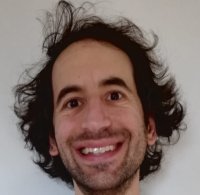
Simon Candelaresi is a post-doc and has been working on magnetic fields in astrophysical objects, such as stars and galaxies Brandenburg, Candelaresi, Chatterjee (2009). His main interest has been the role of magnetic field line topology on the dynamics of plasma systems Candelaresi, Brandenburg (2011) Candelaresi, Del Sordo (2020). There, the magnetohydrodynamic description of the plasma is a suitable model. To solve these equations Simon has been using and co-developing the finite difference code PencilCode and developed the Lagrangian GPU code GLEMuR Candelaresi, Pontin, Hornig; https://epubs.siam.org/doi/10.1137/140967404 written in CUDA. Within the SNuBIC C2 project he is developing methods of coupling, such as interface coupling, grid coupling and the coupling of different equations used (multi-physics). The challenge there is to parallelize such computations efficiently. For more information visit Simon's website: simoncandelaresi.comi.
YK
Yanick Kiechle (PhD Student)
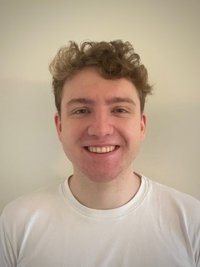
Yanick Kiechle is a PhD student in the SNuBIC research unit. He received both his Bachelor and Master's degree in Mathematics from the Heinrich-Heine-University Düsseldorf. During his studies, Yanick already worked on Active Flux methods and developed a method for the 1+1 dimensional Vlasov-Poisson system. In the B2 project, Yanick will continue to work on Active Flux methods for kinetic plasma equations.
